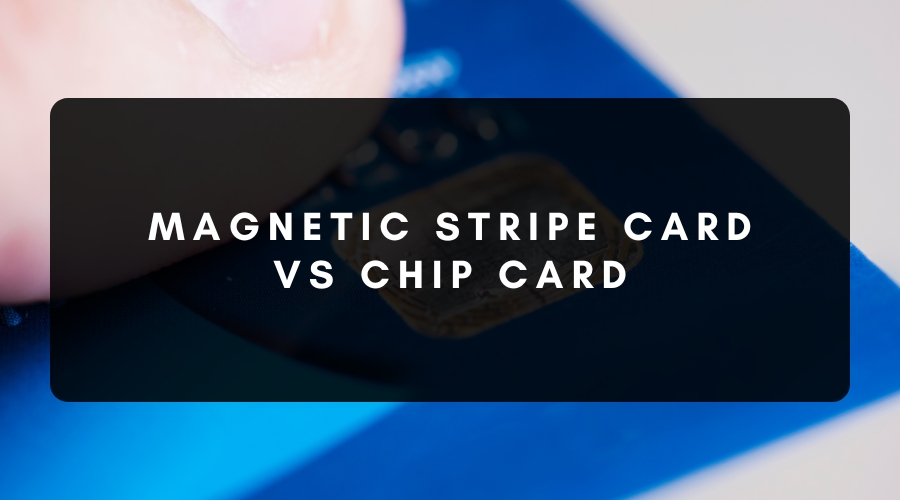
Magnetic Stripe Card vs Chip Card: Which Is Better?
Magnetic stripe cards have been a staple in payment transactions for decades. However, their security flaws are becoming more evident. EMV chip cards have emerged as the more secure alternative, offering advanced protection against fraud.
The shift from magnetic stripe cards to EMV chip cards is reshaping the payment landscape as fraud prevention becomes increasingly critical. Understanding the benefits and challenges of each technology is essential for businesses to ensure secure transactions and meet customer expectations.
What Is a Magnetic Stripe Card?
A magnetic stripe card is a plastic card that uses three horizontal tracks to store data. This data includes the cardholder’s name, account number, balance, service code, and card verification code for point-of-sale (POS) transactions.
The magnetic stripe was developed in the 1960s by IBM engineer Forrest Parry, who created it while designing secure identity cards for CIA officials. After struggling with the process, his wife suggested using an iron to melt the stripe onto the card, which proved successful! In 1969, American Airlines, American Express, and IBM introduced the first plastic credit card with a magstripe—the American Airlines Air Travel Card.
The magstripe card revolutionised payment processing by offering a quick and convenient transaction method. It was used for debit and credit cards primarily before expanding to other applications like driver’s licenses, government ID cards, employee ID cards, hotel keys, gift cards, and loyalty cards.
How Does a Magnetic Stripe Card Transaction Work?
When a card is swiped through a magnetic stripe card reader, the following steps occur:
- The reader extracts the data encoded on the magnetic stripe.
- The terminal sends authorisation requests to the acquiring and issuing banks.
- The issuer verifies details like available funds and the card’s expiration date before approving or declining the transaction.
- The terminal facilitates authorisations between the issuing bank and the acquiring bank.
- Once all authorisations are received, the cardholder signs the receipt and the transaction is complete.
What Is an EMV Chip Card?
EMV chip cards feature a microprocessor chip that securely processes transactions and protects against fraud. EMV stands for Europay, Mastercard, and Visa, the credit card companies that developed the technology. Today, the standard is managed by EMVCo, a consortium equally controlled by Visa, Mastercard, JCB, American Express, China UnionPay, and Discover.
The first chip cards appeared in France in the 1960s, but widespread adoption faced delays due to compatibility issues with payment terminals. In the 1990s, the EMV global standard was established to ensure consistent and interoperable use worldwide.
Adoption of EMV technology surged as data breaches and security concerns grew. The chip’s encryption provides superior fraud protection, making it the global standard for secure card transactions.
How Does an EMV Chip Card Transaction Work?
EMV chip card transactions at point-of-sale terminals involve these steps:
- The card is inserted into the terminal and the terminal’s pins make contact with the chip.
- The chip is activated and the terminal verifies the issuer’s details stored on it.
- The chip authenticates the PIN entered by the cardholder.
- The terminal uses the chip’s public key to digitally sign the transaction.
- The transaction details are sent to the bank for authorisation.
- Once authorised, the transaction is complete.
Magnetic Stripe Card vs EMV Chip Card
Magnetic stripe cards and EMV chip cards differ significantly across several key aspects.
Security
- Magnetic Stripe: Skimming, card cloning, and data theft are major risks in card-present transactions. The static data on magnetic stripes can be easily copied using inexpensive skimming devices, leading to credit card fraud and counterfeit cards.
- EMV Chip: The chip encrypts data and generates a unique code for every transaction, preventing replay attacks. This dynamic data makes it difficult for fraudsters to reuse stolen information.
Chargebacks
- Magnetic Stripe: Fraudulent transactions are harder to trace, leading to higher chargeback rates. Merchants are often at risk of absorbing the cost of fraudulent transactions.
- EMV Chip: The encrypted data and transaction authentication drastically reduce fraud, meaning fewer chargebacks for merchants. This technology can also help identify the party responsible for fraudulent activity.
Payment Processing Fees
- Magnetic Stripe: The higher fraud risk drives up payment processing fees for merchants. Some card issuers charge additional fees for fraud prevention measures.
- EMV Chip: Lower processing fees stem from improved fraud protection and reduced merchant liability. The processing costs for businesses will likely decrease as EMV adoption grows.
Durability
- Magnetic Stripe: Frequent wear and tear can cause issues, particularly with card readers that rely on the magnetic strip for data. This leads to replacement costs and transaction delays.
- EMV Chip: The chip is embedded into the card, offering better durability. EMV cards are less likely to suffer from data-reading issues due to wear, leading to fewer transaction errors and card replacements.
Compatibility With POS Systems
- Magnetic Stripe: Older payment systems are compatible with magstripe cards, but they are becoming outdated and put merchants at risk of not meeting global security standards.
- EMV Chip: Modern terminals that support EMV can also handle multiple payment methods, including contactless and mobile payments. This flexibility ensures that businesses are prepared for current and future payment trends.
Global Trends
EMV chip technology is considered an international best practice for secure transactions. Many governments now require businesses to adopt EMV-compatible systems to combat fraud and enhance payment security.
Magnetic stripe cards are being phased out due to their security vulnerabilities. As of 2024, Mastercard eliminated magnetic stripes from newly issued credit and debit cards. By 2033, all Mastercard credit and debit cards around the world will no longer feature magnetic stripes.
The Role of Contactless Payments
Contactless payments are changing the way in which card transactions are completed due to recent health concerns and the ongoing demand for convenience. Near-field communication (NFC) technology allows consumers to tap their NFC-enabled EMV chip card or device near a terminal for quick, secure payments.
Merchants benefit from tap-to-mobile technology that allows card payments to be accepted on NFC-enabled smartphones. Programs like Mastercard’s Tap on Phone and Visa’s Tap to Phone are driving the adoption of NFC technology by making these solutions more accessible.
What Does This Mean for Merchants?
Merchants must adapt to evolving payment technologies to minimise fraud risks and meet customer demands. Upgrading to EMV-enabled terminals is essential to reduce chargebacks and fraudulent transactions. Supporting magnetic stripe and EMV chip payment cards ensures your business can accommodate customers in regions that are transitioning to newer technologies.
Integrating contactless payment options, including tap-to-mobile, enhances the customer experience by offering fast and secure transactions. Merchant services that include secure payment processing simplify these upgrades by providing tools to manage secure and efficient transactions. Businesses that embrace secure systems reduce liability risks, build customer trust, and position themselves to stay competitive and compliant with industry standards.
The Future of Payment Technologies
Emerging technologies are transforming the future of digital payments by enhancing security and streamlining transactions. These advancements prepare businesses for a digital-first economy while addressing evolving fraud risks.
Secure payment processors that maintain Level 1 Payment Card Industry Data Security Standard (PCI DSS) compliance play a vital role in adopting these innovations, ensuring seamless and secure payment processing across borders.
Biometric Authentication
Biometric authentication works by verifying identity through physical traits, such as fingerprints, facial, iris, palm, or voice recognition, to ensure that only authorised users complete payments. This reduces fraud and enhances consumer confidence in payment systems.
Tokenised Mobile Payments
Tokenisation safeguards payment details during a transaction by replacing sensitive data with encrypted tokens. Tokens cannot be used fraudulently, even if intercepted, offering robust security for mobile payments. Secure payment processors help merchants implement tokenisation effectively.
Quantum-Resistant EMV Technology
As computing power advances, quantum-resistant EMV technology is being developed and used to protect payment data from potential quantum computing threats. Strengthened encryption ensures long-term security and keeps businesses ahead of emerging challenges.
From Magstripe to Chip—The Shift in Payment Security
As payment technology evolves, businesses must adapt to new standards in transaction security. Magnetic stripe cards are being replaced by EMV chip cards, which offer stronger protection against fraud. This shift aligns with global trends towards more secure payment systems.
EMV chip cards are now the standard for secure transactions, making it essential for merchants to upgrade their payment systems. Contactless payments and emerging technologies like biometric authentication and quantum-resistant tech are also transforming the payment landscape. Understanding these changes will help businesses stay ahead of the curve and protect their customers’ data.

